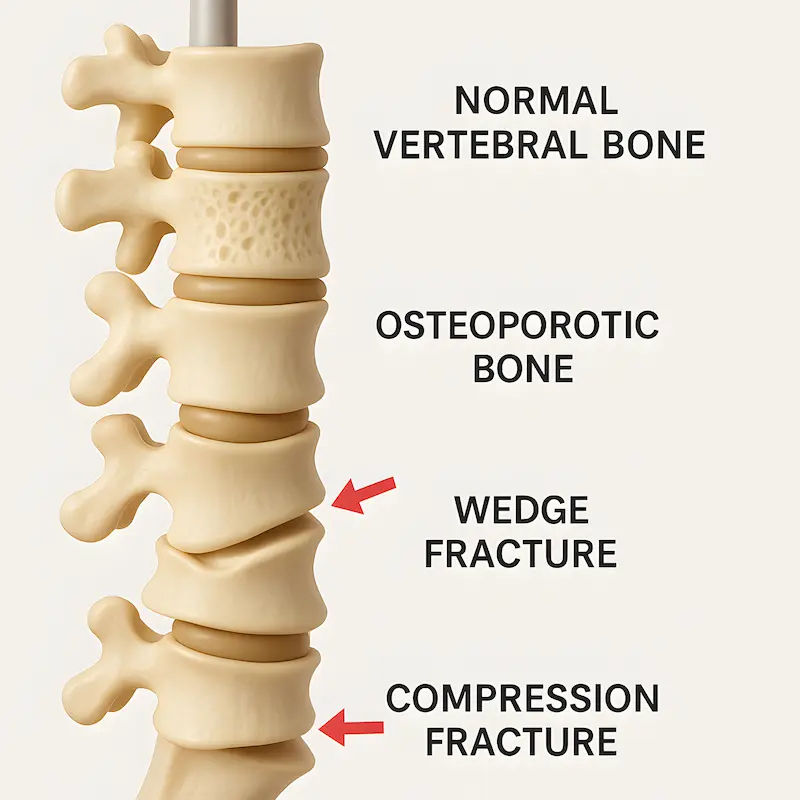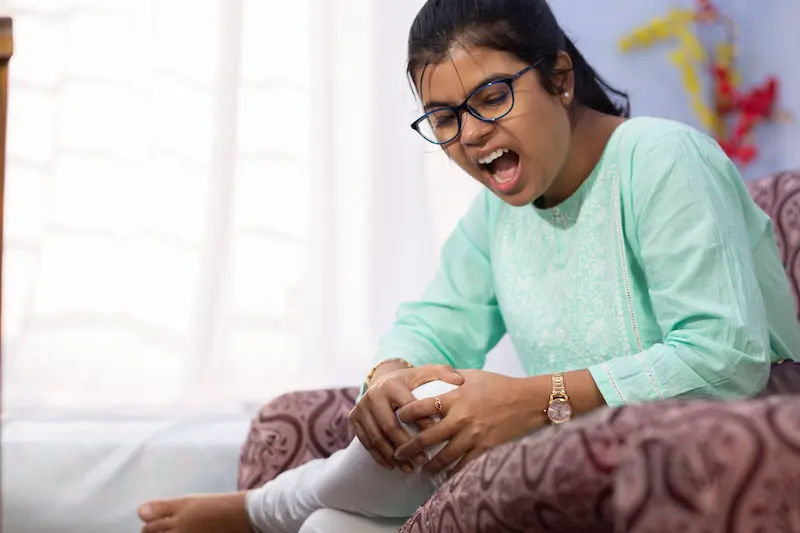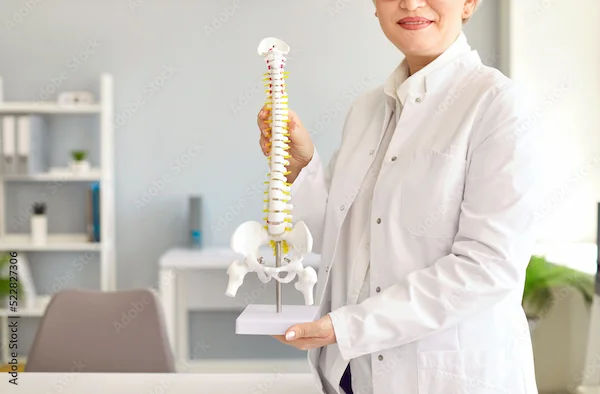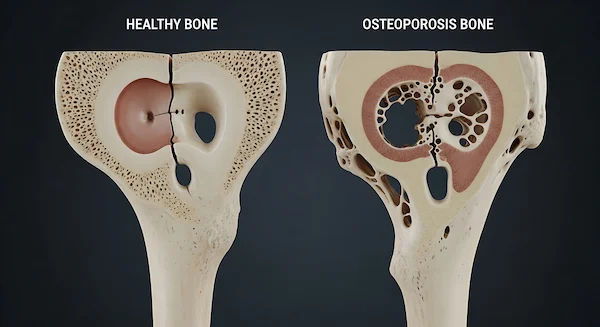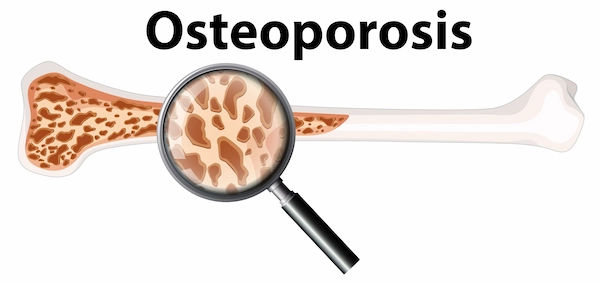Weak Bones? A Comprehensive Guide to Symptoms, Causes, and Stronger Health
Discover the signs, causes, risks, and treatments for weak bones, and learn how to build lifelong strength and prevent osteoporosis.

Written by Dr. M L Ezhilarasan
Reviewed by Dr. Dhankecha Mayank Dineshbhai MBBS
Last updated on 29th Sep, 2025

Introduction
Have you ever wondered if that slight backache or the fact you seem to bruise more easily is a sign of something deeper? You’re not alone. Millions of people live with weak bones, often without realising it until a minor fall leads to a major fracture. The condition, medically known as osteoporosis, is often called a "silent disease" because bone loss can occur without any obvious symptoms. But here's the empowering truth: weak bones are not an inevitable part of ageing. With the right knowledge and proactive steps, you can protect your skeleton and maintain your strength and independence for years to come.
This guide is designed to be your go-to resource. We'll move beyond the fear and confusion to explore what weak bones really mean, how to identify your personal risk factors, and the practical, evidence-based strategies you can implement today—from nutrition and exercise to modern diagnostics and treatments. Whether you're concerned for yourself or a loved one, understanding bone health is the first step towards building a more resilient future.
What Does "Weak Bones" Really Mean? Understanding Bone Density
Bone density is a measure of how strong and resilient your bones are.
At its core, having weak bones means your bones have lost density and strength. Think of healthy bone as a dense honeycomb. When bones become weak, the holes in this honeycomb become larger and more numerous, making the bone more fragile and prone to breaking. This weakening is a result of an imbalance in the natural cycle of bone remodelling, where old bone is broken down and new bone is formed. After age 30, most people begin to lose bone mass slightly faster than they can replace it.
The Silent Thief: Osteoporosis vs. Osteopenia
It's crucial to distinguish between two key terms:
- Osteopenia: This is the precursor to osteoporosis. It means your bone mineral density (BMD) is lower than normal but not yet severe enough to be classified as osteoporosis. Think of it as a warning sign—a critical opportunity to intervene and prevent further bone loss.
- Osteoporosis: This is the more advanced stage, where bones have become significantly porous, brittle, and highly susceptible to fractures. A fracture from osteoporosis can occur from a minor incident, like bending over to tie your shoes or a slight bump.
Understanding this spectrum is vital because it highlights that bone health is a continuum, and actions taken at the osteopenia stage can dramatically alter the outcome.
Are You at Risk? Key Factors That Weaken Your Bones
Recognising what increases your risk of weak bones can help you take control early.
Unchangeable Risk Factors
- Age: Bone loss accelerates naturally after mid-life.
- Gender: Women are at a significantly higher risk, especially after menopause due to a drop in oestrogen.
- Family History: Having a parent or sibling with osteoporosis, especially if they had a hip fracture, increases your risk.
- Body Frame Size: Men and women with small body frames tend to have a higher risk because they may have less bone mass to draw from as they age.
- Ethnicity: Those of White or Asian descent are at highest risk.
Lifestyle and Dietary Contributors
- Low Calcium and Vitamin D Intake: A lifelong lack of calcium plays a major role in the development of weak bones.
- Eating Disorders: Severely restricting food intake and being underweight weakens bone in both men and women.
- Sedentary Lifestyle: People who spend a lot of time sitting have a higher risk of osteoporosis than those who are more active.
- Tobacco and Alcohol Use: Long-term use of tobacco and heavy alcohol consumption interferes with the body's ability to absorb calcium.
- Certain Medications: Long-term use of corticosteroid medications (e.g., for asthma or arthritis) and some other drugs can be detrimental to bone health.
Listening to Your Body: Signs and Symptoms You Shouldn't Ignore
Spotting the early signs of weak bones can make a huge difference to your health.
Consult an Orthopaedician for the best advice
The "Silent" Symptoms
- Receding Gums: Your gums can recede if your jaw is losing bone.
- Weakened Grip Strength: Studies have linked a weaker grip to lower bone density.
- Brittle Fingernails: While not a definitive sign, weak nails can sometimes indicate a nutritional issue affecting bone health.
When Weak Bones Become a Problem: Fracture Signs
The most serious signs are fractures that occur from minimal trauma, known as fragility fractures. Other clear indicators include:
- Loss of Height: Compression fractures in the spine can cause a gradual loss of height.
- Stooped Posture (Kyphosis): Also caused by spinal fractures, leading to a curved upper back.
- Sudden, Severe Back Pain: This can signal a collapsed or fractured vertebra.
If you experience a fracture from a minor fall or notice a change in your posture, it is essential to consult a doctor online with Apollo24|7 for a proper evaluation. Early diagnosis can prevent further complications.
Getting a Diagnosis: How Doctors Test for Bone Health
Doctors use reliable tests to assess bone strength and diagnose osteoporosis.
The Gold Standard: The DEXA Scan
The Dual-Energy X-ray Absorptiometry (DEXA) scan is a quick, painless, and low-radiation test that measures your bone mineral density (BMD), typically at the hip and spine. Your results are given as a T-score, which compares your bone density to that of a healthy young adult.
- Normal: T-score of -1.0 or above
- Osteopenia: T-score between -1.0 and -2.5
- Osteoporosis: T-score of -2.5 or below
Other Diagnostic Tools
Your doctor might also use a FRAX® tool to calculate your 10-year probability of having a fracture. In some cases, blood tests to check calcium, vitamin D, and thyroid levels may be ordered. Apollo24|7 offers convenient home collection for tests like vitamin D, making it easier to get the information you need.
Building a Fortress: Your Action Plan for Stronger Bones
Practical steps can help strengthen your bones and reduce the risk of fractures.
Nutritional Building Blocks: Calcium and Vitamin D
- Calcium: The National Institutes of Health recommends 1,000 mg daily for most adults, increasing to 1,200 mg for women over 50 and men over 70. Focus on dietary sources like dairy products, leafy green vegetables (kale, broccoli), and fortified foods.
- Vitamin D: Essential for calcium absorption. Aim for 600-800 IU daily. Get safe sun exposure and include fatty fish, egg yolks, and fortified milk in your diet. Supplements are often necessary, especially in regions with limited sunlight.
The Power of Movement: Best Exercises for Bone Density
Bones get stronger when they are stressed. The best exercises to prevent fractures are:
- Weight-Bearing Exercises: Activities where you work against gravity. This includes brisk walking, jogging, dancing, and tennis.
- Strength Training: Using free weights, resistance bands, or your own body weight (e.g., squats, press-ups) stresses the bones in your arms and spine, stimulating growth.
Lifestyle Tweaks for Major Impact
- Quit Smoking: This is one of the most significant steps you can take.
- Limit Alcohol: Stick to no more than one drink per day for women and two for men.
- Fall Prevention: Make your home safer by removing tripping hazards, using non-slip mats, and ensuring good lighting.
When Prevention Isn't Enough: Medical Treatments for Osteoporosis
Sometimes lifestyle changes need to be combined with medical treatment.
If you are diagnosed with osteoporosis, your doctor may prescribe medication to strengthen your bones. Osteoporosis treatment options include:
- Bisphosphonates: The most commonly prescribed drugs (e.g., alendronate, risedronate) that slow bone loss.
- Monoclonal Antibody Medications: Such as denosumab (Prolia) or romosozumab (Evenity), which are injections that help build bone.
- Hormone-Related Therapy: For postmenopausal women, oestrogen or raloxifene can help maintain bone density.
It's important to discuss the benefits and risks of each option with your doctor to find the right plan for you. If your condition does not improve after trying lifestyle methods, book a physical visit to a doctor with Apollo24|7 to explore these advanced treatments.
Conclusion: Your Path to Lifelong Bone Strength
Taking action today ensures stronger bones and better mobility for tomorrow.
The journey to overcoming weak bones begins with awareness. By understanding the risks, recognising the subtle signs, and taking proactive steps today, you are investing in a stronger, more mobile tomorrow. Your skeletal health is a cornerstone of your overall well-being, influencing your independence and quality of life. There is no better time than now to prioritise it. Start by incorporating more calcium-rich foods into your next meal, taking a brisk walk, or simply having a conversation with your healthcare provider about your bone health. Your future self will thank you for every step you take towards building a more resilient foundation.
Consult an Orthopaedician for the best advice
Consult an Orthopaedician for the best advice
Dr. Anil Sharma
Orthopaedician
42 Years • MBBS, MS Orthopedics
New Delhi
AAKASH MEDSQUARE, New Delhi

Dr. Anil Pradeep Jadhav
Orthopaedician
23 Years • MBBS MS (Ortho)
Nashik
Apollo Hospitals Nashik, Nashik
(25+ Patients)

Dr. Manoj Dinkar
Orthopaedician
15 Years • MBBS, Dip (Orthopaedics)
New Delhi
THE DOCTORS NESST, New Delhi
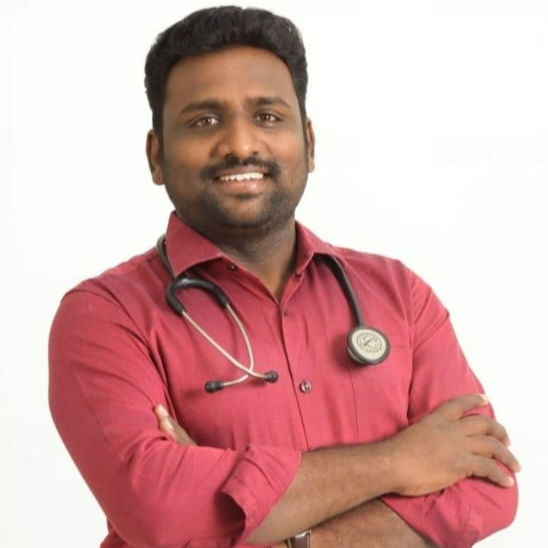
Dr. Pradeep Lucas
Orthopaedician
7 Years • MBBS, Diploma in Orthopaedics, Fellowship in DFSI
Bengaluru
Revival Multispeciality Clinic, Bengaluru
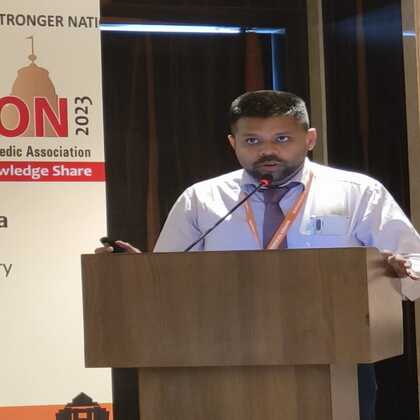
Dr. Mriganka Ghosh
Orthopaedician
11 Years • MD (Physician), DNB (Orthopaedics)
Howrah
Dr Mriganka Mouli Ghosh, Howrah
Consult an Orthopaedician for the best advice
Dr. Anil Sharma
Orthopaedician
42 Years • MBBS, MS Orthopedics
New Delhi
AAKASH MEDSQUARE, New Delhi

Dr. Anil Pradeep Jadhav
Orthopaedician
23 Years • MBBS MS (Ortho)
Nashik
Apollo Hospitals Nashik, Nashik
(25+ Patients)

Dr. Manoj Dinkar
Orthopaedician
15 Years • MBBS, Dip (Orthopaedics)
New Delhi
THE DOCTORS NESST, New Delhi

Dr. Pradeep Lucas
Orthopaedician
7 Years • MBBS, Diploma in Orthopaedics, Fellowship in DFSI
Bengaluru
Revival Multispeciality Clinic, Bengaluru

Dr. Mriganka Ghosh
Orthopaedician
11 Years • MD (Physician), DNB (Orthopaedics)
Howrah
Dr Mriganka Mouli Ghosh, Howrah
More articles from Osteoporosis
Frequently Asked Questions
Can young people get weak bones (osteopenia/osteoporosis)?
Yes, while less common, young adults can develop low bone density due to factors like hormonal disorders, long-term use of certain medications (e.g., steroids), eating disorders, or prolonged inadequate nutrition and exercise.
What are the best calcium supplements for adults if I don't get enough from my diet?
Look for supplements containing calcium citrate or calcium carbonate. Calcium citrate can be taken with or without food and is often better for older adults with less stomach acid. Always check with your doctor for the appropriate dosage, as too much calcium can cause issues.
Are there any specific symptoms of vitamin D deficiency related to bone health?
Vitamin D deficiency can be subtle. Symptoms can include bone pain, muscle weakness, and frequent bone fractures. However, many people are asymptomatic, which is why testing is important if you have risk factors.
I'm postmenopausal. What is the single most important thing I can do for my bones?
It's a combination, but if forced to choose, ensuring adequate calcium and vitamin D intake, coupled with regular weight-bearing and resistance exercise, is the most powerful natural strategy. A DEXA scan to know your baseline is also highly recommended.
Can you rebuild bone density after it's lost?
Yes, to some extent. While it's challenging to completely restore bone to its peak density, you can significantly increase bone density and strength through medication, proper nutrition, and targeted exercise, especially if you start early in the process (like at the osteopenia stage).
